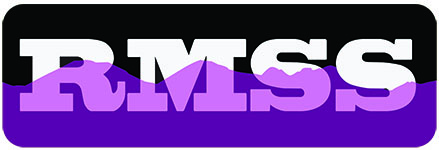2019
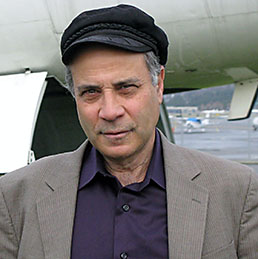 | DR ROBERT ZUBRIN – President of Pioneer Astronautics, an aerospace R&D company located in Lakewood, Colorado. He is also the founder and President of the Mars Society, an international organization dedicated to furthering the exploration and settlement of Mars by both public and private means. Formerly a Staff Engineer at Lockheed Martin Astronautics in Denver, he holds a Masters degree in Aeronautics and Astronautics and a Ph.D. in Nuclear Engineering from the University of Washington. Zubrin is the inventor of several unique concepts for space propulsion and exploration, the author of over 200 published technical and non-technical papers in the field, and was a member of Lockheed Martin’s “scenario development team” charged with developing broad new strategies for space exploration. In that capacity, he was responsible for developing the “Mars Direct” mission plan, a strategy which by using Martian resources, allows a human Mars exploration program to be conducted at a cost 1/8th that previously estimated by NASA. Zubrin is known internationally as one of the most creative engineers working in the aerospace industry today, and he and his work have been subject of much favorable press coverage in The Economist, The New York Times, The Boston Globe, the London Times, The Washington Post, Fortune Magazine, Newsweek, Air and Space Smithsonian, Popular Science, Space News, and many other publications, and he has appreared on the Discovery Channel, CNN, NPR, and the BBC. He is the holder of 15 US Patents. In addition to his many technical publications, Dr. Zubrin is the author of seven books, including “The Case for Mars: How We Shall Settle the Red Planet and Why We Must,” published by Simon and Schuster’s Free Press in Oct. 1996, “Entering Space: Creating a Spacefaring Civilization,” published by Tarcher Putnam in Aug. 1999, “Mars on Earth: Adventures of Space Pioneers in the High Arctic,” published by Tarcher Penguin in Sept. 2003, “Energy Victory: Winning the War on Terror,” published by Prometheus Books in November 2007, the humorous “How to Live on Mars: A Trusty Guidebook to Surving and Thriving on the Red Planet,” published by Random House in December 2008, and “Merchants of Despair: Radical Environmentalists, Criminal Pseudoscientists, and the Fatal Cult of Antihumanism,” published by Encounter Books in 2012. Since founding Pioneer Astronautics in January 1996, Dr. Zubrin has served as the Principal Investigator of over 60 research and development efforts in areas including spacecraft and launch vehicle propulsion systems, Mars and Lunar in-situ resource utilization technology, EVA life support and propulsion, and robotic exploration systems. Prior to that, for 7 years, Dr. Zubrin was employed as a Senior, and then Staff Engineer at Lockheed Martin (formerly Martin Marietta) Astronautics in Denver, working on the design of advanced space transportation and propulsion concepts. He won two Inventors awards from Martin Marietta for his design of a nuclear rocket engine that could use CO2 as propellant, allowing a vehicle so powered to have unlimited mobility on Mars, and for his design of the “Mars Direct” mission architecture. While at Lockheed Martin, Zubrin also worked on many other projects ranging from small ICBM and missile defense systems to robotic Mars balloon missions, space nuclear power, and the design of aerial-refueled rocketplanes. |
 | LANA & EDUARD TRYGUBOVA – Graduated from Sikorsky Polytechnic University, Kiev Ukraine, in 1992. They both earned Master of Science Degrees in Optics and Opto-Electronic Devices and Instruments and have worked over 30 years in the optical industry. The first work for both of them was in the Soviet Union defense sector making lenses and optical scales. This was just before the collapse of the Soviet Union. After graduation Eduard founded the Technical Optics Company in the Ukraine and produced optics for JMI, ARO, TEC and local customers. In five years the company moved to the USA and merged with TEC. Since then Eduard introduced his oil spaced triplet design and started telescope production on American soil. The latest company Eduard and Lana founded is Agema Optics, Inc. Eduard came up with an innovative doublet lens design which can compete with triplet lens correction and brought it to market making it available for amateurs. The company also makes optics for universities and industry. Eduard's role model is D.D. Maksutov. He started to collect information about this famous optician during his school years and he is an author of several papers about Maksutov's biography and his inventions. |
 | DR BRIAN S. PENN – Has the usual qualifications (Ph.D. in Geology from a tier-1 university: the Colorado School of Mines, '94) prerequisite of an overachiever who embraced the unrealistic prognosticated demands for technically educated individuals. His extensive experience in the equally arcane fields of Computer Science (MS, the University of Texas at Arlington) and Remote Sensing is derived from serendipitous opportunities in various interesting, though largely economically meaningless, application areas. The upshot of these experiences render him unemployable to the world at large and only sullies his reputation among his so-called peers. However, Dr. Penn's idealistic nature continues to foster the delusion that some of the stuff he does matters. |
 | BARRY "BEAR" YOUNG - Barry Young is a retired information security analyst and has been teaching Astrophotography for the Colorado Springs Astronomical Society (CSASTRO) for 3 years. He has extensive experience as a machinist and has built many telescopes and other related equipment, In addition to teaching the Novice Astrophotography classes, he is the Starry Meadows Land Committee Chairman and is currently overseeing many improvements to the property. Barry will be presenting Session 1: Intro to Astrophotography as well as Session 2: Entry Level Equipment for Astrophotography. |
 | AIDAN JANNEY – Is a 9th grade student at Coronado High School in Colorado Springs. He loves to explore everything science related, especially the fields of astronomy, physics, and chemistry. He has a 4.57 GPA and loves going to school. Although he has no qualifications besides a desire to learn, Aidan also greatly enjoys the fields of theoretical physics and astrophysics. He is known as the definitive science nerd to his friends and constantly bothers everyone around him with obscure science and space trivia. Aidan has been a member of CSASTRO for a year and a half and has enjoyed every minute of it. |
2018
 | FRAN BAGENAL – Dr Fran Bagenal was born and grew up in England. She studied Physics and Geophysics at the University of Lancaster. In 1976, inspired by NASA’s missions to Mars and the prospect of the Voyager mission, she moved to the US for graduate study at MIT. Her 1981 PhD thesis involved analysis of data from the Voyager Plasma Science experiment in Jupiter’s giant magnetosphere. She spent 1982-1987 as a post-doctoral researcher in space physics at Imperial College, London. Voyager flybys of Uranus and Neptune brought her back to the US and she joined the faculty at the University of Colorado, Boulder in 1989. She was professor of Astrophysical and Planetary Sciences until 2015 when she chose to focus on New Horizons and Juno. She remains a Research Scientist at the Laboratory of Atmospheric and Space Physics. In addition to the Voyager mission, Dr Bagenal has been on the science teams of the Galileo mission to Jupiter and the Deep Space 1 mission to Comet Borrelly. She edited Jupiter: Planet, Satellites and Magnetosphere (Cambridge University Press, 2004). She heads the plasma teams on the first two New Frontiers missions: the New Horizons mission that - after a 9.5-year flight - flew past Pluto on July 14, 2015 and Juno that went into orbit over the poles of Jupiter in 2016. NASA's Juno Mission to Jupiter: What’s Inside the Giant Planet? Underneath its dense cloud cover, Jupiter safeguards secrets to the fundamental processes and conditions that governed our solar system during its formation. With its suite of science instruments, Juno investigates the existence of a solid planetary core, maps Jupiter's intense magnetic field, measures the amount of water and ammonia in the deep atmosphere. JUNO is also the first spacecraft to fly over Jupiter’s aurora and measures both the energetic particles raining down on the planet and the bright “northern & southern lights” they excite. NASA’s JUNO mission was launched in August 2011 and put into orbit over Jupiter’s poles on 4th July 2016. As our primary example of a giant planet, Jupiter can also provide critical knowledge for understanding the planetary systems being discovered around other stars. |
 | AMANDA R. HENDRIX - Is a Senior Scientist with the Planetary Science Institute, based in Boulder. She worked for twelve years at NASA's Jet Propulsion Laboratory and was the Deputy Project Scientist for the Cassini–Huygens mission (2010-2012). She has been a scientific investigator on the Cassini, Galileo and Lunar Reconnaissance missions, a principal investigator on NASA research and Hubble Space Telescope observing programs, and is the author of many scientific papers. Her science focus is on moons in the solar system, including Earth’s moon and those of Jupiter and Saturn, their composition and evolution. She co-authored Beyond Earth: Our Path to a new Home in the Planets, published by Penguin/Random house in Nov 2016. Hendrix received a B.S. in Aeronautical Engineering from Cal Poly, San Luis Obispo and an M.S. and Ph.D. in Aerospace Engineering Sciences from the University of Colorado Boulder. |
 | ROGER KENNEDY – Currently the director of the New Mexico Chapter of the Charlie Bates Solar Astronomy Project. Have presented over 700 outreach programs throughout the USA during the past 6 years, while engaging over 100,000 visitors. A scientific career that spans a 55 year time period; from remote sensing activities with the Navy in the later stages of the Corona Project, academic work at the high school and college level, public interpretation of data from NASA’s Mar Exploration Rover Mission and the Solar Dynamic Observatory, to museum exhibit construction. Advanced graduate training/degrees in Earth & Space Science, Science Education and Supervision, and Spectroscopy from New Mexico Tech., Temple, Bowling Green State, and West Chester Universities among others. |
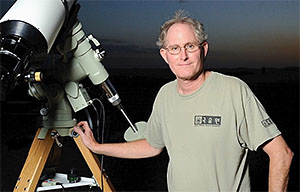 | BILL TSCHUMY – SkySafari is the most popular mobile astronomy app among amateur astronomers. Hear one of the creators, Bill Tschumy, tell you about the app’s history, current status and where it is headed in the future. Bill has been an avid amateur astronomer for the past 45 years and a software engineer for 37. Eight years ago he was fortunate to be able to combine his programming skills and love of astronomy to help create astronomy software for iOS, Android and Mac. Bill co-wrote the award winning SkySafari, StarSeek, Stella Access, Pluto Safari, Eclipse Safari, and Satellite Safari. He has also co-written SkyWeek, Jupiter's Moons and Saturn's Moon which are currently marketed by Sky & Telescope. |
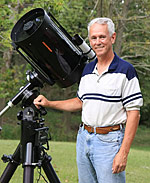 | BOB MORROW - Ever since he was given a Tasco refractor (234 power!) in the early 1960’s, Bob Morrow has been interested in astronomy. He was a familiar sight at the Griffith Observatory, north of Los Angeles, where he spent countless hours at the museum and in the planetarium. During his undergraduate work at the U. S. Air Force Academy, his ambitious project in astronomy class was to photograph all the Messier objects through the school’s 10-inch Celestron SCT. He gave up after hours of collecting photons from the ring and crab nebulae onto GAF 500 film. They were barely visible. Bob finally acquired his own C11 and discovered that the views of the skies in rural Indiana were fantastic…when the telescope was collimated. Unfortunately, that wasn’t often, and recollimating was a real challenge using the factory screws. Eventually, Bob realized that the factory screws could be replaced with knobs, and Bob’s Knobs was born. Now collimation could be done while looking through the eyepiece and without threatening the corrector plate with a pointed tool. After sending another set to an internet forum member, requests for knobs began arriving in droves. Bob got busy designing knobs for other telescope makes and models, creating a web site www.bobsknobs.com, and learning about packaging and shipping. Bob’s Knobs are now available for collimating over 100 different telescope models, and for various mounts so they can be assembled without tools. |
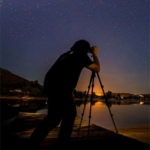 | R.J. SMITH – Currently working at Software Bisque as the Systems Engineer and Staff Astrophysicist, he became enthralled with astronomy while attending Ralston Valley High School in Arvada, Colorado in 2013. In a senior-level astronomy course, he taught himself astrophotography using the school’s 8-inch Meade LX-200 SCT and Mead DSI camera. From there, his passion for astronomy took him to the University of Colorado Boulder, where he graduated with a Bachelor of Science in Astrophysics in the spring of 2016. During his tenure at CU, he was the technical lead, or “Systems Overlord” at the Sommers-Bausch Observatory (SBO) on the CU campus. A project to modernize the observatory’s antiquated telescopes introduced him to Software Bisque in 2017. R.J. keeps busy traveling to faraway places on Occultation Expeditions with SWRI, NASA, and NSF, and another NSF research trip to record the 2017 Total Solar Eclipse in the northwestern U.S. His blog detailing these adventures, and more, can be found at www.bisque.com/sc/blogs/rj_smith_blog. |
More speaker profiles for 2018 coming soon…
2017
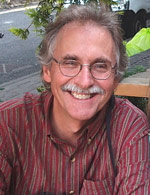 | DR. JOHN SPENCER – John Spencer is an Institute Scientist at the Southwest Research Institute in Boulder. He grew up in England, obtaining a BA in Geology from the University of Cambridge in 1978, and a PhD in Planetary Sciences at the University of Arizona in 1987. He then worked at the University of Hawaii and Lowell Observatory in Arizona, before joining Southwest Research Institute in 2004. His primary interest is in the moons and other small bodies of the outer solar system, which he studies with ground-based telescopes, the Hubble Space Telescope, and interplanetary spacecraft. He serves on the science teams of the the Cassini Saturn Orbiter, the Europa Clipper mission, the new Lucy mission to the Trojan asteroids, and is deputy project scientist the New Horizons mission to Pluto and the Kuiper Belt. He was also a science team member on the Galileo Jupiter Orbiter. In 2016 he received the Whipple Award from the American Geophysical Union, for outstanding contributions to planetary science. “Cassini Mission”. |
 | ROGER KENNEDY – Currently the director of the New Mexico Chapter of the Charlie Bates Solar Astronomy Project. Have presented over 700 outreach programs throughout the USA during the past 6 years, while engaging over 100,000 visitors. A scientific career that spans a 55 year time period; from remote sensing activities with the Navy in the later stages of the Corona Project, academic work at the high school and college level, public interpretation of data from NASA’s Mar Exploration Rover Mission and the Solar Dynamic Observatory, to museum exhibit construction. Advanced graduate training/degrees in Earth & Space Science, Science Education and Supervision, and Spectroscopy from New Mexico Tech., Temple, Bowling Green State, and West Chester Universities among others. |
 | BOB MORROW - Ever since he was given a Tasco refractor (234 power!) in the early 1960’s, Bob Morrow has been interested in astronomy. He was a familiar sight at the Griffith Observatory, north of Los Angeles, where he spent countless hours at the museum and in the planetarium. During his undergraduate work at the U. S. Air Force Academy, his ambitious project in astronomy class was to photograph all the Messier objects through the school’s 10-inch Celestron SCT. He gave up after hours of collecting photons from the ring and crab nebulae onto GAF 500 film. They were barely visible. Bob finally acquired his own C11 and discovered that the views of the skies in rural Indiana were fantastic…when the telescope was collimated. Unfortunately, that wasn’t often, and recollimating was a real challenge using the factory screws. Eventually, Bob realized that the factory screws could be replaced with knobs, and Bob’s Knobs was born. Now collimation could be done while looking through the eyepiece and without threatening the corrector plate with a pointed tool. After sending another set to an internet forum member, requests for knobs began arriving in droves. Bob got busy designing knobs for other telescope makes and models, creating a web site www.bobsknobs.com, and learning about packaging and shipping. Bob’s Knobs are now available for collimating over 100 different telescope models, and for various mounts so they can be assembled without tools. |
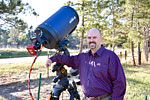 | DR. DAVID STRONG - David Strong grew up in Oklahoma and received a B.S. in Electrical Engineering from Oklahoma State University where he was commissioned into the Air Force. He worked several aircraft avionics systems, including the KC-135, C-130, F-22, and F-35, up until 2004. In 2007, he received a PhD in Electro-Optics from the Air Force Institute of Technology where he specialized in removing atmospheric turbulence blurring of telescope images through post processing. After graduation, he was assigned to the Air Force Maui Optical and Supercomputing (AMOS) site where he was the director for imaging research. Starting in 2010, he taught in the Physics Department at the US Air Force Academy (USAFA), where he retired from active duty in 2014. Since then, he has been an independent researcher with the Center for Space Situational Awareness Research (CSSAR) at USAFA. In addition, he works for Harris Corporation in the sustainment of Air Force optical systems. Currently, he is the Chief Systems Engineer for the Space Surveillance Telescope (SST) for Harris. For more information go to: electroopticalimaging.com. |
 | ERICK WHITE - Erick White is a 7th grade student in the Gifted Magnet Program at Sabin Middle School in Colorado Springs, Colorado, and has been the youngest active member of the Colorado Springs Astronomical Society since 2013. He loves everything space, has since he was four, and is working toward being an astronaut. He enjoys chemistry, math, and reading, has maintained a 4.0 GPA for the past two years, and is a member of the National Junior Honor Society. He currently operates an Orion SkyQuest XT10i IntelliScope as well as a Celestron C4.5 Newtonian reflector. At RMSS 2014, Erick presented “Nebulae”; this year he will be presenting, “Using Spectroscopy to Detect Methane Levels in the Atmospheres of Uranus and Neptune.” |
2016
DR. JOHN SPENCER – Institute Scientist at the Southwest Research Institute in Boulder, “New Horizons – Pluto Encounter”.
DR. PAMELA GAY – Nationally known Astronomy writer and podcaster, Dr. Gay is an assistant research professor in the STEM center at Southern Illinois University Edwardsville, and the Project Director for CosmoQuest. “Collecting Photons with Purpose: Using Telescopes for Science and for Education”.
2015
DR. FRAN BAGENAL – Professor of Astrophysical and Planetary Sciences, Laboratory for Atmospheric and Space Physics, University of Colorado, Boulder. “The Arrival of New Horizons at Pluto”.
TOM FIELD – Contributing Editor, Sky and Telescope Magazine. “Spectroscopy for the Amateur Astronomer”.
2014
FRAN BAGENAL – Professor of Astrophysical and Planetary Sciences, Laboratory for Atmospheric and Space Physics, University of Colorado, Boulder. “Juno – Revealing Jupiter Inteior” and “New Horizons Mission to Pluto”.
ROBERT NAEYE – Editor in Chief, Sky and Telescope Magazine “Amateur Exoplanet Achievements”.
2013
MICHAEL BICAY – Director of Science, NASA Ames Research Center. “The Future of Mars Research” and “The Search for New Earths”.
MIKE SIMONSEN – Membership Director and Development Officer, American Association of Variable Star Observers. “Variable Stars, the AAVSO and You” and “Astronomy: Hobby or Addiction?”
